|
       
| |
Context:
A topic which fascinates us is the
question of "What did the Chinese pioneers eat during the Gold Rush days
and beyond?". Our research into this topic included interviews
with folks who were fortunate enough to have grown up in a Chinese family
environment during the last days of the Gold Rush. As well, we drew
on our life experience, as well as observations from a number of field trips,
notably to China, Chinatowns in San Francisco, New York City and a number of
cities in South East Asia, such as Hong Kong, Singapore, Penang, Kuala Lumpur
etc. where the Chinese have a long history of settlement in these places.
Our observation is that, the style of
the "common family convenient meal" 家常便飯
Hoisan: gar cheung ben faan; Cantonese:
ga seung bin faan; Pinyin: jia chang biàn fàn; ) has hardly changed over the
years, or even from Chinatown to Chinatown, i.e. from one Chinese community to
another. Sure enough, there may be subtleties, minor variation and
adaptation using locally available ingredients.
There is a common theme: use all
parts of the plant or animal, waste not want not, application of preserved
vegetables, fermented soy beans, the ubiquitous soy sauce, salt fish,
preserved meat, Chinese sausage and other time-honoured spices common to a
Chinese kitchen.
In time, it is our intention to
elaborate, but for the time being, we treat you to a pictorial view of a
Heritage Dinner we hosted recently.
_______________________________________________________________________
Menu for a Chinese
Heritage Dinner
As designed by the Chinese
Heritage Interest Network
Starters
Village-style rice porridge traditionally
served at breakfast.
The hot bowl of porridge is served with a
variety of tiny dishes; the taste of each dish is aimed at awakening one’s
sense of simplicity and earthiness. This is a typical Cantonese meal enjoyed by
the young and old, the wealthy or those of modest means alike.
Given the simplicity and popularity of
this style of cooking, it is entirely possible that rice porridge would have
been the staple breakfast meal of the Chinamen of the Golden Age. In some
Chinese families, porridge is welcome not only as a breakfast meal, but also at
other meal times.
On this occasion, the compliment
includes:
· Lightly salted deep fried peanuts
· Thousand-year old egg, with
pickled ginger
· Salted duck egg
· Preserved bean curd cube
· Pork floss
· Pickled cabbage hearts
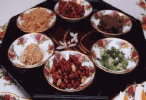


1000 Year-old Egg Salted Duck Egg
Soup
 | Sizzling Rice Soup |
This is another popular dish, developed
by people keen to make use of any available scrap of food and to minimise food
wastage. The base of this dish is a traditional herbal, pork-bone or vegetable
soup, simmered for hours, over a slow stove. Burnt rice (燶飯
-- nung faan), or rice crust formed at
the bottom of a rice pot (飯焦
-- faan jiu ) as a result of rice cooked in the traditional
absorption method, is carefully scraped out, further dried or deep-fried and
then added to a simple soup. The hot soup is poured over the burnt rice,
usually at the dinner table and in the presence of guests, it makes a sizzling
noise, hence the name - sizzling rice soup. Nothing goes to waste.
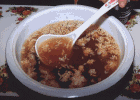
Main Courses
Earthen-pot Salted fish and Chicken rice
or plain rice, served with:
 | Hoinam chicken. (海南雞飯)
Hoisan: Hoinam cheung ben faan; Cantonese:
hoi naam gai faan; Pinyin: hai nan ji fàn; ) This is a speciality
dish originating from the island of Hoinam, usually served cold with a
number of sauces, for example, a mixture of oyster and sesame sauce or
finely chopped ginger and spring onions. For the best result, the chicken
should be a corn-fed, or free-range chicken. Stolen chicken is particularly
tasty as well. The cooking method though simple, can be quite tricky.
Patience and great faith must be exercised in preparing this dish. Once
the preparation of the dish has started, one must exercise great
patience, and resist the temptation of lifting the pot lid, to inspect the
cooking. For the cooking process calls for the chicken to be lowered, breast
side down, into a pot of boiling spiced liquid. The liquid is once again
brought to the boil and left to cook for a few minutes, the duration is
dependent on the size of the chicken. The pot is then covered and the heat
turned off. No more visible heat is required from here onwards. |
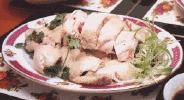
 | Pork with preserved vegetable. This is
a highly complicated, explosive dish, not to be tried in a Western home
kitchen environment. It is a triple-cooked dish. The preparation process
includes marinating, boiling, air-drying, deep broiling (this is when the
pork will explode), careful slicing of the pork (without destroying the
delicate shape of the pork), addition of the preserved vegetable complete
with the rich sauce and finally the dish steamed for hours. The preserved
vegetable is usually Chinese mustard green, preserved and stored in an
earthen pot. The preserved vegetable keeps well and for years, this type of
vegetable has been exported from China, to all corners of the globe. The
oversized jar is often recycled as a container to hold liquid, such as oil,
drinking water. The pot is often mistaken by non-Chinese as "ginger
jar". |
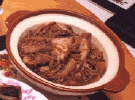
 | Stuffed Bitter Melon. (Hoisan: Young
Foo Qua) This dish is for
the connoisseur of Southern Chinese regional cuisine. The melon is bitter,
but the after-taste is clean, clear and subtle. Stuffing used ranges from
fish paste to minced pork mixed with chopped vegetables or dried prawns.
Cooking method ranges from pan frying, to serving in clear soup –
something preferred by the Hakka people.
|
 | Kai-toy. As pronounced by the Toisan
people, this is another Southern Chinese vegetable dish, loved by
connoisseur for its subtle bitter taste. Today we are treated to a variety
of baby Kai-toy. |

 |
Steamed Trout. This is
a fresh water fish, prepared in the traditional Cantonese style. The trout
can be substituted with any other fresh fish. Its sauce is simple, the
cooking method is disarmingly straight forward – a process of steaming,
once the fish has been carefully prepared. Yet there is a risk of delivering
a below par plate, as the steaming period must be just right and the sauce,
complete with a fine balance of ginger, spring onion and pepper.
In
the attached link, we have included the recipe for Steamed
Fish. |
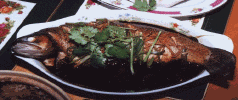
Dessert
· Coconut and bean slice.
· Red bean and glutinous rice
pudding
Coffee & Sweets
. Fi-shang (花生)
toffee (peanut toffee), as described by
Sir Lionel Lindsay in his book "Comedy of Life"
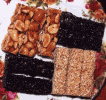
|